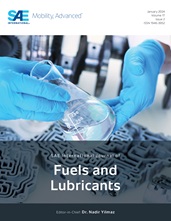Multiple-injection strategies are characterized by a complex and transient interplay between high- and low-temperature reactions. Tracking low-temperature reaction products such as formaldehyde (CH2O) is particularly important to understand ignition phenomena and the so-called “combustion recession” that is observed in experiments. Experimentally, it is often difficult to discriminate between formaldehyde and other species such as poly-aromatic hydrocarbons, which is why a selective excitation approach is used in this work. Simultaneous high-speed imaging of the chemically-excited hydroxyl radical (OH*) is used to improve indication of flame location and second stage ignition. During experiments in a constant-volume vessel, two 0.5-ms injections of n-dodecane, separated by 0.5-ms dwell time, are injected into a 900-K ambient. The global flame development is characterized based on high-speed diagnostics, followed by an investigation into the spatial distribution of formaldehyde at four different times after start-of-injection (aSOI). Results show significant influence of the first injection on characteristics of the second. Ignition delay and lift-off location of the second injection are prominently reduced, while flame penetration is greatly enhanced by the wake of the first injection. Formaldehyde structure is observed during both end-of-injection transients, reaching as far upstream as 6 mm from the nozzle. Even after the second injection, the flame structure still appears to be influenced by the first, with a shorter lift-off length and compressed formaldehyde structure. Based on the selective excitation procedure, it becomes clear that the interpretation of laser-induced fluorescence (LIF) images obtained by 355-nm excitation alone is prone to ambiguity.
